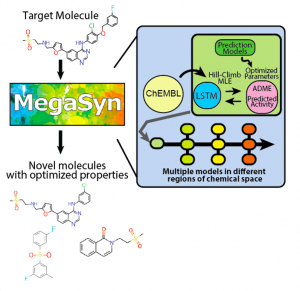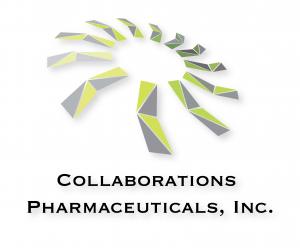Collaborations Pharmaceuticals, Inc. Announces Publication on Generative Molecule Design Software MegaSyn
Collaborations Pharmaceuticals, Inc. announces the publication of a paper detailing their generative molecule design software, MegaSyn.
Generative machine learning models have become widely adopted in drug discovery and other fields to produce new molecules and explore molecular space, with the goal of discovering novel compounds with optimized molecular properties. These generative models are frequently combined with transfer learning or scoring of physicochemical properties to steer generative design yet often they are not capable of addressing a wide variety of potential problems, as well as converge into similar molecular space when combined with a scoring function for desired properties. In addition, these generated compounds may not be synthetically feasible, reducing their capabilities and limiting their usefulness in real-world scenarios. In this paper we introduce a suite of automated tools called MegaSyn representing 3 components: a new hill-climb algorithm which makes use of SMILES-based recurrent neural network (RNN) generative models, analog generation software, and retrosynthetic analysis coupled with fragment analysis to score molecules for their synthetic feasibility.
We show that by deconstructing the targeted molecules and focusing on sub-structures, combined with an ensemble of generative models, MegaSyn generally performs well for the specific tasks of generating new scaffolds as well as targeted analogs which are likely synthesizable and drug-like. We now describe the development, benchmarking, and testing of this suite of tools and propose how they might be used to optimize molecules or prioritize promising lead compounds using these RNN examples provided by multiple test case examples. Several examples are included to demonstrate the potential of the software including the rediscovery of the recently described psychoplastogen tabernanthalog, after starting with the psychedelic drug ibogaine said Dr. Urbina.
MegaSyn is available for licensing and for use in fee for service projects we undertake with companies.
*Fabio Urbina, Christopher T. Lowden, J. Christopher Culberson, Sean Ekins, MegaSyn: Integrating Generative Molecular Design Automated Analog Designer, and Synthetic Viability Prediction, ACS Omega, https://doi.org/10.1021/acsomega.2c01404
Sean Ekins
Collaborations Pharmaceuticals, Inc.
+1 215-687-1320
email us here
Visit us on social media:
Twitter
LinkedIn
Legal Disclaimer:
EIN Presswire provides this news content "as is" without warranty of any kind. We do not accept any responsibility or liability for the accuracy, content, images, videos, licenses, completeness, legality, or reliability of the information contained in this article. If you have any complaints or copyright issues related to this article, kindly contact the author above.


